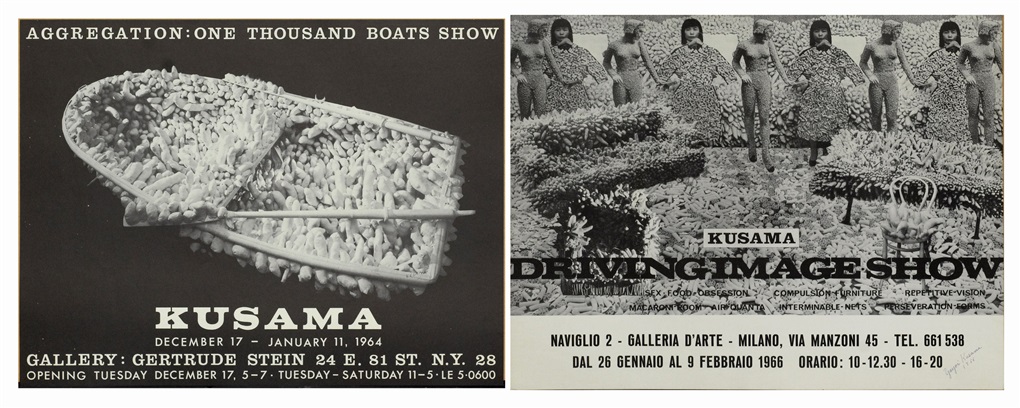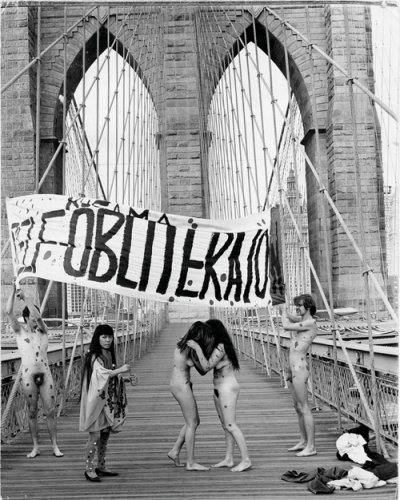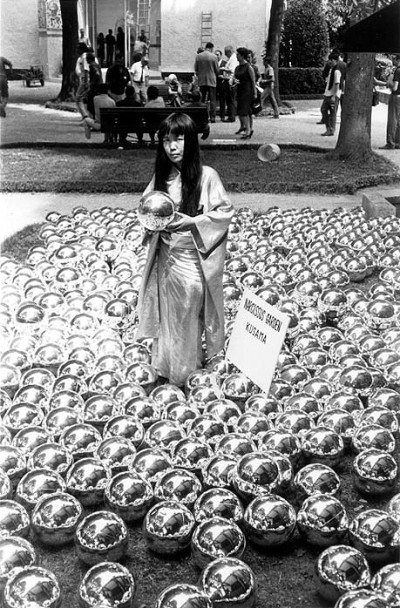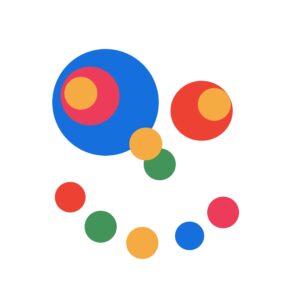Part 1: The Original Obliteration Room and Children's "Play"
Connections with Kusama's Early Installations
Installation art refers to a type of art into which the viewer physically enters a space, often described in the cases of Kusama’s installations as “immersive” and “theatrical.”[1] Kusama’s immersive artworks offer the museumgoer a new perspective on their lived reality. By taking the familiar space of the home and perverting it by painting it entirely white in her Obliteration Room, Kusama is providing audiences with an alternative experience in which they are invited to reconsider their own interaction with museum spaces. Her actualization of the desire to ask her participants to reflect on the museum as an institution through her art gradually expanded, beginning in the 1950s with her Happenings and her monumental Infinity Nets. She then evolved her immense but two-dimensional artworks into fully enveloping spaces for her audiences in her 1964 Driving Image Show before creating her first Infinity Mirror Room in 1965 and finally her 2002 Obliteration Room.

According to art historian Claire Bishop, installation art represents the artist’s desire to heighten the viewer’s awareness of how objects are positioned in a space and the viewer’s bodily response to them. It is a form of site-specific art. The work changes shape or form based on the time and length that the exhibition is up for, the culture of the location and museum it is in, and the amount of and types of people that encounter and participate in the installation. Viewers are activated and decentered, addressed directly by the work of art and, by extension, the artist. Instead of a representational experience, audiences are presented with elements directly to experience and are denied one ideal place to view at the work, expanding the visual experience beyond the two dimensional.[2] In installation artworks, the space, the art, the objects, and sometimes even the audiences engaging with the work are regarded as a singular artistic totality.[3]

As Bishop has further argued, installation art as a form of contemporary art practice began with the Environments and Happenings of the late 1950s in which Kusama actively participated.[4] Installation art has no straightforward lineage, though, as it is also inspired by theater, land art, cinema, architecture, painting, set design, curation, sculpture and performance art.[5] Kusama arrived in New York City, one of the sites of this experimentation in art, in 1957. Her career was launched in October 1959 with a solo show at Brata Gallery, displaying five of her Infinity Net paintings which consisted of incredibly large scale, 10 ft. long canvases painted with repetitive, curved white lines which overlapped and connected to each other, forming a large web-like appearance with no central focal point or center.[6] These paintings were larger than life-sized, allowing her audiences to feel small and lost when viewing the works and examining the patterns along the surface. Their size then allowed Kusama to later use them as walls for her first all-encompassing installation.
In addition to paintings, sculptures are also important to Kusama’s installation art. Kusama first delved into sculpture (more specifically, “soft sculpture” or sculpture made with fabric and sewn resembling plush objects) in 1962 at the Green Gallery with the first of her Accumulation series, Accumulation No. 1 (armchair), a chair covered in hundreds of hand-made and white-painted phallic protuberances.[7] Her later additions to this series would include a couch covered in similar sewn sculptures. At the New York Castellane Gallery in 1964, Kusama presented the exhibition Driving Image Show, in which she showed pasta-covered mannequins and phallus-covered furniture. She used her Infinity Net paintings as a backdrop and added raw macaroni on the floor for the audience to walk on and crunch, marking her arrival at a totally immersive art experience in which viewers were surrounded by art on all sides (Fig. 13).[8]


Kusama’s Infinity Mirror Room – Phalli’s Field, a later example of her soft sculpture “accumulations,” first shown at the Castellane Gallery in 1965 (and later recreated) is Kusama’s first completely immersive installation as well as one of the first examples of installation art ever, marking a cultural shift from artwork as object to artwork as a situation.[9] On November 3, 1967, Kusama staged her second solo show, Love Room, at the Internationale Galerij Orez in the Hague in which she included her first whole room covered in polka dots, Infinity Polka Dots Room.[10] The key room consisted of a painted white space filled with five mannequins painted with fluorescent paint and covered by polka dots in various sizes. If Infinity Polka Dots Room uses mannequins as stand-ins for both Kusama and her audience, then her later Happenings were a full realization of participants as polka dot-speckled art pieces (Fig. 18). The polka dot- covered room was also her first polka dot environment, setting into motion a decades-long career of site-specific installations consisting of mirrored, macaroni-covered, and polka-dotted rooms in which visitors interact. In The Obliteration Room, Kusama included many objects that would become features of her soft sculptures, such as painted white couch pillows, cushions, and plush toys (Fig.19). However, these soft sculptures are found objects, rather than objects sewn by Kusama’s hand. The stickers in The Obliteration Room could also be seen as another form of “accumulation” by the process in which they gather and are built up in a nonspecific order or order only known to the participant who applied them.

[1] Claire Bishop, Installation Art: A Critical History / Claire Bishop, (New York: Routledge, 2005): 90.
[2] Bishop, Installation Art, 90; Bishop, Installation Art, 6-11.
[3] Bishop, Installation Art, 90; Bishop, Installation Art, 6-11.
[4] Bishop, Installation Art, 90; Bishop, Installation Art, 6-11.
[5] Bishop, Installation Art, 90; Bishop, Installation Art, 6-11.
[6] Yayoi Kusama, Infinity Net: The Autobiography of Yayoi Kusama / Yayoi Kusama translated by Ralph McCarthy., English ed. (Chicago: University of Chicago Press, 2011): 26, 30; Antje von Graevenitz, “Kusama’s Key Concepts of Infinity Nets and Self-Obliteration: Unequal Correspondences in Europe in the 1960s,” in Yayoi Kusama: A Retrospective edited by Stephanie Rosenthal (Munich: Prestel Verlag, 2021): 68.
[7] Lenz, Kusama – Infinity, [10:08].
[8] Yamamura, Yayoi Kusama: Inventing the Singular, 108, 112, 125.
[9] Marie Laurberg, “Amid Infinity: Yayoi Kusama’s Immersive Installations,” in Yayoi Kusama: A Retrospective edited by Stephanie Rosenthal (Munich: Prestel Verlag, 2021): 282-285.
[10] Kusama and Rosenthal, Yayoi Kusama: A Retrospective / Edited by Stephanie Rosenthal, 23.
